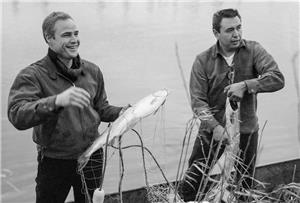On August 27, 1988, members of the Puyallup Tribe of Indians vote to approve settlement of $162 million in cash, real estate, and economic development programs in exchange for abandoning claims to some 18,000 acres of land on its historic reservation on Commencement Bay. The agreement will resolve questions over property titles and free the Port of Tacoma to develop its land. It is the second-largest settlement between the government and Indians in American history. The first signature on the agreement is that of Tacoma Mayor Karen Vialle, whose great grandfather witnessed the signing of the Medicine Creek Treaty in 1854. The Medicine Creek Treaty established the Puyallup Reservation. On March 25, 1990, the Tribe will formally accept the settlement.
Dispute Dating to 1854
On December 26, 1854, representatives of the Puyallups signed the Medicine Creek Treaty with the United States under which they ceded their claims to land in Washington Territory in exchange for a small reservation, hunting and fishing rights, and promises of cash payments. In 1857, President Franklin Pierce expanded the reservation to 18,060 acres in response to Indian grievances that precipitated the 1855-1956 Treaty Wars. The reservation lay along the Puyallup River and Commencement Bay. The boundaries of the reservation remained unquestioned until Tacoma began to grow in the 1860s and 1870s. The completion of the transcontinental railroad in the 1880s spurred settlement and Indian lands became prime real estate.
In 1887, Congress passed the Dawes Severality Act, which divided reservations among individual tribal members. Through additional Congressional action, manipulation of processes by greedy developers, and fraud, much tribal land was alienated, that is, sold out of Indian hands. By 1934, when the allotment program ended, twentieth-century Puyallups held just 33 acres, including the tribal cemetery, in a depressed area at the edge of Tacoma.
Beginning in the 1960s, the tribe and individual members began to assert their fishing rights and their rights to reservation land through acts of civil disobedience as well as through legal actions. In 1974, U.S. District Court Judge George Boldt upheld the original treaty language as to fishing rights, which had been opposed by the State of Washington. In 1978, the tribe sued to gain title to 12 acres of former riverbed (left high and dry by a rechanneling of the Puyallup River) occupied by the Port of Tacoma in 1950, but never paid for. In 1984, the U.S. Supreme Court let stand a lower court ruling in favor of the tribe. The tribe received a $77 million judgment.
With that victory the Puyallups filed suit against the Union Pacific Railroad to reacquire 160 acres along the shores of Commencement Bay and the Puyallup River. This suit brought in the Port of Tacoma and the Burlington Northern Railroad. It presaged claims by the tribe to the rest of the original reservation, including the entire city of Fife, Interstate 5, part of downtown Tacoma, and the Port of Tacoma. All titles to land on the original reservation was called into question, complicating the ability of owners to borrow money or sell their property. In 1984, Washington voters passed Initiative 456, which asked Congress to declare steelhead a game fish (but more broadly a referendum against Native American treaty rights).
Negotiated Settlements
The Port of Tacoma and municipalities came into the case to forestall incessant litigation and unfavorable court judgments. The parties negotiated settlements in 1985 and 1987, but the proposals ignited intense feelings among the Puyallups who were divided by intra-tribal rivalries, rumors, and on the wisdom of accepting cash for their birthright. Although the Tribal Council signed off on each settlement, tribe members rejected both deals at the ballot box. As negotiations stumbled, the tribe sent eviction letters to dozens of farmers and landowners on 270 acres that lay inside reservation boundaries in order to bring them to the settlement table.
Congressman Norm Dicks, chairman of the House Committee on Indian Appropriations, asked U.S. Senator Daniel K. Inouye of Hawaii to enter the case in his role as Chairman of the Senate Select Committee on Indian Affairs. Inouye got talks started again. In August 1988, the tribe voted again on a settlement offer and passed it 319 to 162. In exchange for abandoning claims to the original reservation, the tribe received 900 acres of waterfront property, a per-capita payment of $20,000, a trust fund, employment opportunities, and a subsidy to improve the Blair Waterway, including a new bridge. The money came from the state and federal governments, corporations, and municipalities.

